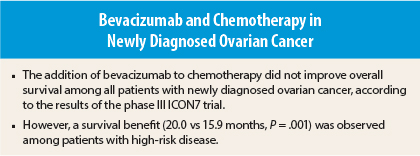Final overall survival results of the phase III ICON7 trial reported in The Lancet Oncology by Amit M. Oza, MD, and colleagues indicate no significant improvement with the addition of bevacizumab (Avastin) to standard chemotherapy in women with newly diagnosed ovarian cancer.1 However, an overall survival benefit of bevacizumab was observed among women with high-risk disease. ICON7 had shown that bevacizumab improved progression-free survival, the primary endpoint, with the largest benefit in high-risk disease.2
Study Details
A total of 1,528 women from Europe, Canada, Australia, and New Zealand took part in the open-label ICON7 trial. They were randomized between December 2006 and February 2009 to receive chemotherapy (n = 764; six 3-weekly cycles of carboplatin AUC [area under the receiver operating characteristic curve] 5 or 6 and paclitaxel 175 mg/m²) or the same regimen plus bevacizumab 7.5 mg/kg every 3 weeks given concurrently and continued with up to 12 additional 3-weekly cycles of maintenance therapy (n = 764). Patients had to have newly diagnosed epithelial ovarian, fallopian tube, or primary peritoneal cancer, an Eastern Cooperative Oncology Group (ECOG) performance status of 0 to 2, International Federation of Gynecology and Obstetrics (FIGO) 1988 stage IIb to IV or high-risk (grade 3 or clear cell histology) stage I to IIa disease, and have undergone debulking cytoreductive surgery or, in advanced disease, a biopsy with no further surgery planned.
Totals of 254 chemotherapy group patients and 248 bevacizumab group patients were categorized as being at high risk of progression due to stage IV disease, inoperable stage III disease, or suboptimally debulked (> 1 cm) stage III disease.
Overall, patients had a median age of 57 years; 94% had an ECOG performance status of 0 or 1; 89% of those with cancer originating from a single site had cancer of ovarian origin; 69% had serous histology; 11% had FIGO stage III, IIIA, or IIIB disease; and 70% had stage IIIC or IV disease. After primary surgery, 26% of patients had residual disease > 1 cm, 24% had residual disease ≤ 1 cm, and 48% had no visible residual disease.
Overall Survival
The median follow-up was 48.9 months. In the primary analysis, the median overall survival was 58.0 months (95% confidence interval [CI] = 52.4–66.9 months) in the total bevacizumab group vs 58.6 months (95% CI = 53.5–67.5 months) in the total chemotherapy group (P = 0.85) and 39.7 months vs 30.2 months (P = .003) among the 502 patients with poor-prognosis disease. However, the results showed evidence of nonproportional hazards for outcome among all patients and among poor-prognosis patients (P values for nonproportionality = .02 and .01).
Thus, analysis estimating survival differences during a 5-year period (difference in restricted mean survival time) was used as the primary estimate of effect. On this analysis, no benefit of bevacizumab was observed among all patients (restricted mean survival = 45.5 vs 44.6 months, hazard ratio [HR] = 0.99, 95% CI = 0.85–1.14). However, a significant benefit was observed among the 502 patients with poor-prognosis disease (restricted mean survival time = 39.3 vs 34.5 months, HR = 0.78, 95% CI = 0.63–0.97). No difference was observed among the patients without poor-prognosis disease (48.4 vs 49.7 months, HR = 1.14, 95% CI = 0.93–1.40).
Updated Progression-Free Survival
In the primary progression-free survival analysis, reported at 759 events, restricted mean progression-free survival was 21.8 months in the bevacizumab group vs 20.3 months in the chemotherapy group (HR = 0.81, P = .004), with an increased benefit observed in the high-risk subgroup (HR = 0.73, P = .002).2 In the current updated analysis, at 1,080 events, there was no longer a significant benefit with bevacizumab (restricted mean progression-free survival = 29.2 vs 27.7 months, P = .25), although a significant benefit was observed among high-risk patients (20.0 vs 15.9 months, P = .001). That said, Dr. Oza commented to The ASCO Post that in terms of progression-free survival analysis, the initial significant finding should be considered the primary result for consideration.
The investigators concluded: “Bevacizumab, added to platinum-based chemotherapy, did not increase overall survival in the study population as a whole. However, an overall survival benefit was recorded in poor-prognosis patients, which is concordant with the progression-free survival results from ICON7 and GOG-218 and provides further evidence towards the optimum use of bevacizumab in the treatment of ovarian cancer.” ■
Disclosure: The study was funded by the National Institute for Health Research through the UK National Cancer Research Network, Medical Research Council, and Roche. For full disclosures of the study authors, visit www.thelancet.com.
References
1. Oza AM, Cook AD, Pfisterer J, et al: Standard chemotherapy with or without bevacizumab for women with newly diagnosed ovarian cancer (ICON7): Overall survival results of a phase 3 randomised trial. Lancet Oncol 16:928-936, 2015.
2. Perren TJ, Swart AM, Pfisterer J, et al: A phase 3 trial of bevacizumab in ovarian cancer. N Engl J Med 365:2484-2496, 2011.



